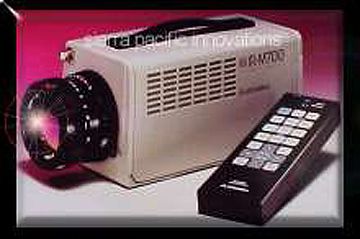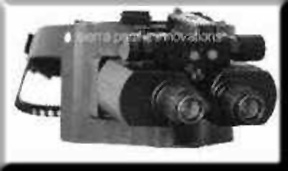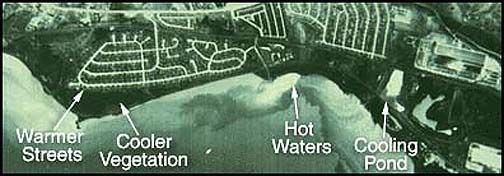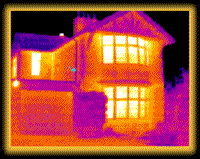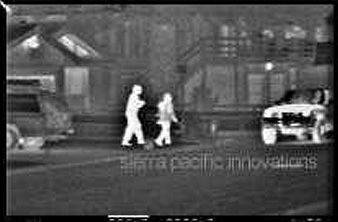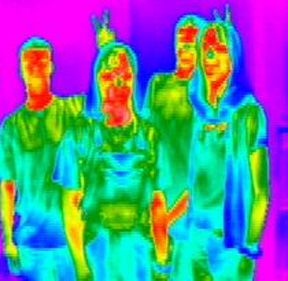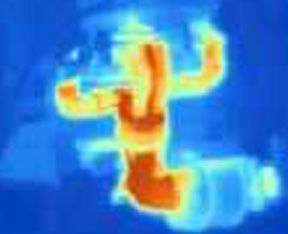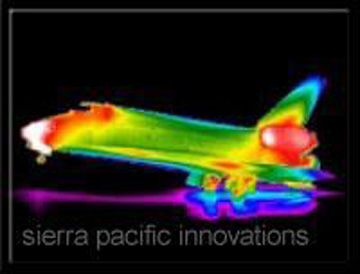Thermography; Night Vision Systems¶
>
Thermal imaging, as well as use of specialized thermal detectors, has grown into an important technology that is applied directly by users on the ground or from low-flying aircraft. The field is commonly called thermography. Using thermal sensors coupled with optical systems, one is able to “see in the dark” by detecting varying temperatures from different objects in the scene. Typical users include hunters and law enforcement officials; there are a number of military uses. Another frequent application is to check for heat loss from buildings or thermal contamination in streams.
Thermography; Night Vision Systems¶
We would be remiss if we didn’t bring to your attention a wide range of applications of thermal remote sensing that involve aerial flights and, now routinely, ground studies with infrared instruments that are portable - even hand-held - and easy to master with little training. Most of these uses involve operating the equipment at night. Probably the most dramatic display of this expanding technology was the graphic scenes during the Gulf War of 1990 in which CNN and other networks showed the Iraqi defense in Baghdad as a series of greenish-color live-action firings of anti-aircraft tracer flights and occasional hits by incoming missiles. This was a thermal IR display using TV cameras equipped with sensors that responded to the thermal variations of features, from buildings to weaponry, in the scene. Many other applications can be cited: in industry, process control, energy audits (heat expenditure and loss), machinery function; in law enforcement, police surveillance; in firefighting, search and rescue, wild fire reconnaissance, smoke penetration; in medicine, abnormal variations of body heat related to disease and malfunctions, in environment, wildlife observation and management, oil spill detection; and much more.
All of these tasks depend on detecting temperature differences in objects that vary in their thermal response. For example, hot spots in a building could indicate inefficient energy distribution including unwanted heat leaks. Tanks and soldiers on the move can be monitored at night. Felons breaking into a closed bank stand out as warm bodies moving about in a suspicious manner. An abnormally warm area around the human throat could mean a thyroid disorder.
This now widely used technology, called Thermography depends on scanners and cameras with detectors sensitive to emitted thermal radiation. In the 3-5 µm region, Indium-Antimony (InSb) and Platinum silicide materials are sensitive to radiation in that spectral interval, with thermal photons knocking off electrons to create the varying signals that indicate temperature differences. In the 8-14 µm region, Mercury-Cadmium-Telluride detectors are used. Detectors that respond to quantum effect radiation require cooling. Others, that rely on what is known as the pyroelectric effect, can be uncooled; these include radiometers and ferroelectric bolometers. Depending on what is done with the signals, the imaging systems can be shown visually in black and white, in green tones, or in color (by assigning different colors to different temperatures). The sensors can detect over wide temperature ranges (e.g., from - 20 to +1100°C) while being able to measure temperature differences as small as 0.5 to 1.0 degree. We show examples of two instruments. First, is a hand camera marketed by Sierra Pacific Innovations (check their interesting Home Page) called the IRM 700.
This camera, which has a platinum silicide detector sensing radiation between 1.2 and 5.9 µm, produces high resolution images, like the one below, to a kilometer or more range.
The second is even more exotic. Here is a set of Night Goggles which can be worn by a person directly over the eyes. It has proved invaluable to police raiding a building, firefighters, and hunters, as well as military personnel in combat.
` <>`__9-19: Think of several (imaginative) ways in which you could use Night Goggles. `ANSWER <Sect9_answers.html#9-19>`__
This next image shows the view through a telescopic sight adapted to thermal infrared detection of a deer (whether this is a hunter’s target or the subject of a naturalist’s study is not known).
We can learn more about these diverse uses of thermography - especially the Night Vision mode - just by looking at some representative images. Let us turn first to energy budget assessments, in which both aerial and ground thermal scenes look for abnormalities in heat distribution. Start with this aerial scanner night view of a residential area.
The warmer areas are the river, particularly a light-toned plume that results from industrial fluids being dumped and a cooling pond that receives water from a nearby plant (warm signature). In the residential section, houses are cool but the streets display higher temperatures since they are asphalt covered (this black tar material absorbs solar energy during the day and re-radiates thermal energy at night).
The next scene is a colorized depiction of temperature variations in a series of homes and other buildings. The reds and white denote “hot spots” - either from small workshops or from individual houses in which excessive heat is being lost.
Heat variations abound in individual houses, as shown here:
At the street level, this night scene shows people, an auto, and houses in terms of relative hotness:
` <>`__9-20: Note the house on the left, and particularly its roof. There are two bright pattern “hot spots” on or near the roof. What might they be? Account for the hot areas on the auto in the right part of the scene. **ANSWER**
Individuals in everyday clothing appear as distinct temperature variants. Their faces usually are warmer (reds) than their outside clothes (in cooler greens and blues):
The human body, unclothed, reveals surprising differences in temperature, much being normal but occasionally with areas whose thermal departure from the norm may have significant health implications. In this case, the small white area on the back is indicative of a potential problem.
Individual inanimate objects experience temperature differences as they operate. Two examples will suffice. First, peruse this thermogram (another word for thermal image) of a motor doing its thing.
And, consider the heat distribution within this pipe fitting:
Returning to a space theme, here is a thermal snapshot of the Space Shuttle as it landed at Cape Canaveral.
` <>`__9-21: Explain the two larger areas of warmer temperatures on the Shuttle. `ANSWER <Sect9_answers.html#9-21>`__
Finally, let’s take a quick peek at one aspect of military use - here the appearance of a tank and a supply truck operating actively during maneuvers.
We can safely conclude from this review that thermal imagery opens new vistas in seeing the Earth’s surface in a way largely unfamiliar to our experience. Thermal sensing is a versatile way to detect and identify features, using properties we seldom sense directly - certainly not with our eyes. There are two other kinds of thermal images not considered in this section: views of people and action imaged by “night vision” methods (a variant was amazingly presented as targets in Iraq during the 1991 Gulf War); and views of heat concentrating or escaping around a home being surveyed by thermal scanners for heat leaks. Hot stuff, eh!
Untitled
